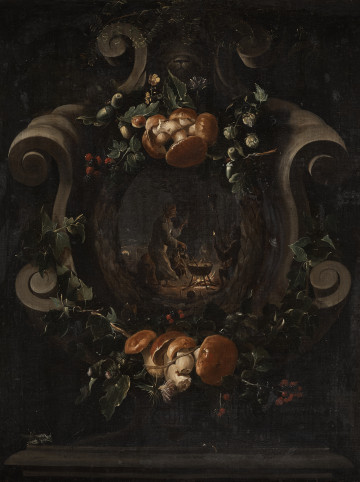
Florists on the waterfront
19th (?) century
Castle Museum in Łańcut
Part of the collection: Painting and drawing
Stanisław Kaczor-Batowski, Horse train in Shamraivka, 1912, (Signed and dated S.Batowski 13 6 1912 Szamrajówka). The painting depicts a four horse-drawn carriage – “black” palace model, ready for departure, using the most colourful and most original tack from the Kresy borderlands – named bałagulska, from the local name of horse cart drivers. In the foreground, the painting by Batowski depicts horses in tack, the main topic of the painting. Shamraivka, near Bila Tserkva, the famous residence of the Braniccy family in the Ukraine, where in 1778 hetman Franciszek Ksawery established the first Polish purebred horse farm. In 1912, from which the painting stems, Shamraivka belonged to Baria Branicka nee Sapieha. The end of the rich locality of Bila Tserkva was orchestrated by the 1917 revolution and the peace of Riga, by way of which these lands never made it into the Second Polish Republic. The painting is uniquely beautiful, painted in subdued colours, so wonderfully recreating the dry, steppe air of the historic Polish Kresy. The beauty of the painting that covers the customs of the land always causes so much emotion, but these are also very objectively significant for our culture and the history of the Polish Kresy – making the painting even more valuable. The painting by Kaczor-Batowski is also valuable as a document. The main topic are the horses in the foreground, with the bałagulska tack and the bells on the necks – called szeptuny – stylish and unique in its character, the original borderland horse tack of the Braniccy. The topic of the painting is also linked to the very broad movement of the horse cart drivers in the borderlands, and the remains of their culture in local customs. Part of these were the special bałagul horse trains, used at Polish courts and palaces until the year 1939. Aldona Cholewianka- Kruszyńska
Author / creator
Dimensions
height: 40 cm, width: 80.5 cm
Object type
Painting and drawing
Technique
oil
Material
wood, canvas
Origin / acquisition method
decyzja administracyjna
Creation time / dating
Creation / finding place
Owner
Castle Museum in Łańcut
Identification number
Location / status

19th (?) century
Castle Museum in Łańcut

19th (?) century
Castle Museum in Łańcut

17th century
Castle Museum in Łańcut
DISCOVER this TOPIC
Castle Museum in Łańcut
DISCOVER this PATH
Educational path